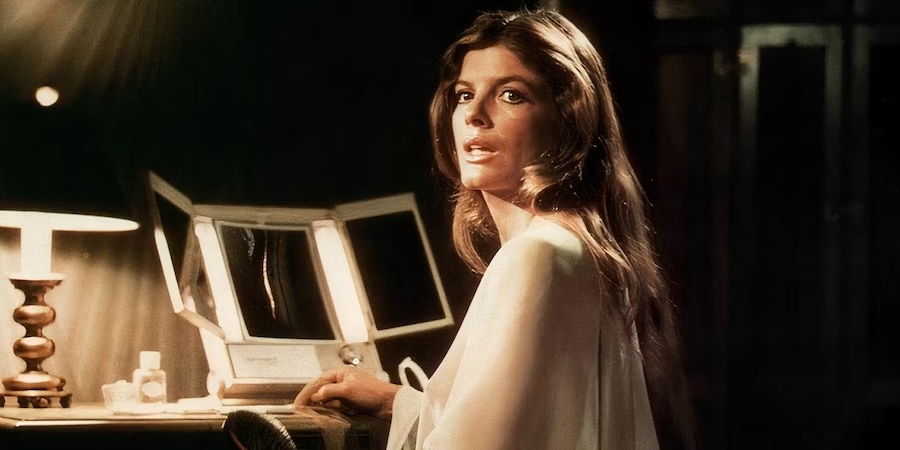
SOMETHING STRANGE IS HAPPENING IN THE TOWN OF STEPFORD.

Screenwriter William Goldman was less than happy about director Bryan Forbes’s lack of integrity. The filmmaker had cast his wife, Nanette Newman, as one of the seemingly brainwashed Stepford wives. She was not considered to be a bombshell, so Forbes decided that the original idea of having those women dress like Playboy bunnies should be abandoned. Instead, the actresses were clad in big-brimmed hats and dresses that covered their bodies. Credibility suffered; as Goldman argued, if one should stay true to the story there is no way that these women would cover up their bodies. In the end though, the film did most things right.
A lovely suburb with good neighbors
I’m writing this review trying not to reveal the film’s secret (although it may not be much of a secret these days). The story begins with Joanna and Walter Eberhart (Katharine Ross, Peter Masterson) moving out of New York with their two kids. They’re headed to Stepford, Connecticut, a lovely suburb where nothing much happens and good neighbors make friends easily. Joanna is not too comfortable about the move; her husband talked her into it but she does miss the city.
Still, there’s ample opportunity for her to indulge in her hobby as a photographer. She finds a new friend, Bobbie Markowe (Paula Prentiss), and together they begin to question women’s lifestyle in Stepford; all their neighbors seem to do is bake and take care of the household, nothing else. And they’re always happy and cheerful, extremely devoted to their husbands. Joanna and Bobbie begin to wonder if there’s something in the water…
Uncertain about the signs
You can see the similarities between this story and author Ira Levin’s previous “Rosemary’s Baby”; both have the central female character sense that something evil is going on and realize that few believe her. The thing is that the filmmakers make sure that we in the audience remain just as uncertain about the signs as Joanna right up until the final sequences when everything is revealed. Some critics complained about the leisurely pace, but that’s nonsense; Forbes creates an environment of fear (even though life in Stepford looks positively sunny) and we’re handed many clues to what’s going on, including the first sequence where a guy carries a mannequin. Sympathy is effectively built for Ross and Prentiss’s characters; they’re both perfect as the only free-spirited women of an oddly conservative society.
One of the great things about this film is that it is equally effective as a chiller and a satire on equality and what role women should play in modern marriages; Goldman’s script has several amusing ingredients and funny lines, especially the ones delivered by Prentiss.
The final sequence is horrifically brilliant. Still, once again I have to question the way the Stepford wives dress; it’s one key factor that is all wrong. Anne of Green Gables will never be how most men imagine the woman of their dreams.
The Stepford Wives 1975-U.S. 115 min. Color. Directed by Bryan Forbes. Screenplay: William Goldman. Novel: Ira Levin. Cast: Katharine Ross (Joanna Eberhart), Paula Prentiss (Bobbie Markowe), Peter Masterson (Walter Eberhart), Nanette Newman, Patrick O’Neal, Tina Louise… Dee Wallace, Mary Stuart Masterson.
Trivia: Diane Keaton, Jean Seberg and Tuesday Weld were considered for the part of Joanna; Brian De Palma for directing duties. Mary Stuart Masterson’s film debut. Followed by three made-for-TV sequels, starting with Revenge of the Stepford Wives (1980); remade as The Stepford Wives (2004).
Last word: “The scene in which I, portraying Kit Sunderson, recall [Forbes’s] talented direction was the following: All us wives were seated in a group therapy session when the topic turned to how our husbands were forcing us to do intense housework and we were rebelling. But instead of objecting to the masculine brow beating, eager to please any male when the topic was cleaning, I said, ‘It took me so long to get my upstairs floor to shine, I didn’t have any time to bake.’ ‘Have you ever tried Easy Off?’ my girlfriend asked. ‘Is it really that good?’ I replied. Bryan wanted me to think about a life and death situation and the gravity this would imply. ‘Listen to Toni, Carole. You’re not listening to her,’ Bryan yelled. And he was right. The music became chime-like and eerie and the audience was given a clue that I was dead. That all the wives were dead. We were servants to our husbands. Slaves. Zombies in house dresses. Not wives. Loving wives. This was a pivotal scene and Bryan made it work because he watched our performances like a myopic hawk and was forceful in his direction. We all listened to him especially when he yelled which wasn’t often.” (Carole Mallory, who played one of the Stepford wives, Huffington Post)
